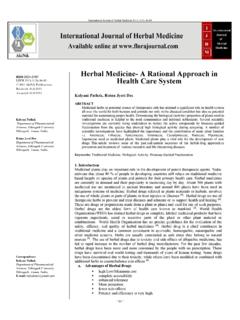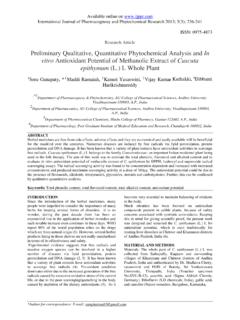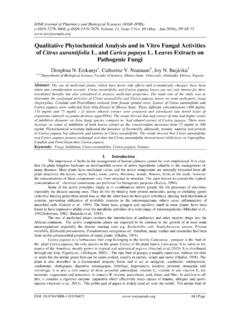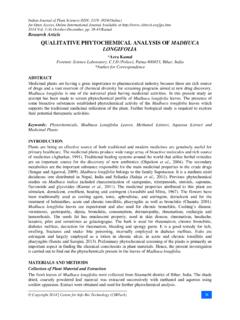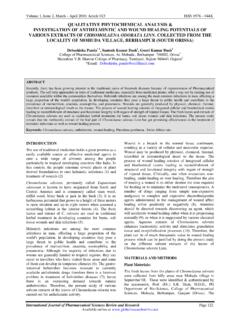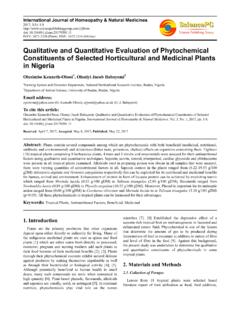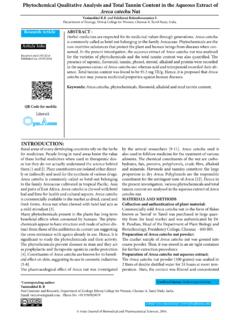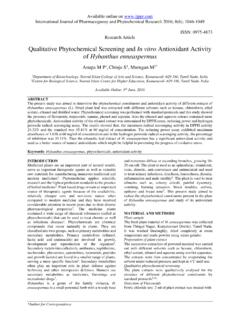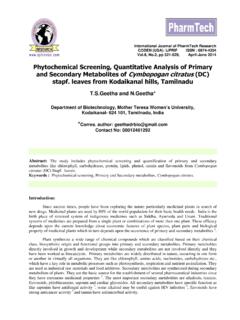Transcription of ISSN Studies on qualitative, quantitative, phytochemical ...
1 ~ 30 ~ International Journal of Herbal Medicine 2014; 2 (3): 30-36 ISSN 2321-2187 IJHM 2014; 2 (3): 30-36 Received: 13-10-2014 Accepted: 29-10-2014 E. Kamala Pranoothi Department of Biotechnology, Acharya Nagarjuna University, Nagarjuna Nagar, Guntur, India 522510. K. Narendra Department of Biotechnology, Acharya Nagarjuna University, Nagarjuna Nagar, Guntur, India 522510. Suman Joshi Department of Biotechnology, AcharyaNagarjuna University, Nagarjuna Nagar, Guntur, India 522510. J. Swathi Department of Biotechnology, Acharya Nagarjuna University, Nagarjuna Nagar, Guntur, India 522510. Sowjanya Department of Biotechnology, Acharya Nagarjuna University, Nagarjuna Nagar, Guntur, India 522510. Rathnakarreddi Department of Biotechnology, Acharya Nagarjuna University, Nagarjuna Nagar, Guntur, India 522510.
2 Rev Fr. S. Emmanuel Department of Biotechnology, AcharyaNagarjuna University, Nagarjuna Nagar, Guntur, India 522510. Ch. Padmavathi Department of Biotechnology, Acharya Nagarjuna University, Nagarjuna Nagar, Guntur, India 522510. A. Krishna Satya Department of Biotechnology, Acharya Nagarjuna University, Nagarjuna Nagar, Guntur, India 522510. Correspondence: Alapati Krishna Satya Assistant Professor Coordinator-Department of Biotechnology Coordinator (DBT-BIF Centre) Acharya Nagarjuna University Nagarjuna Nagar, Guntur 522510 Andhra Pradesh. India. Studies on qualitative , quantitative, phytochemical analysis and screening of in vitro biological activities of Leucas indica (L) VAR. Nagalapuramiana E. Kamala Pranoothi, K.
3 Narendra, Suman Joshi, J. Swathi, Sowjanya, Rathnakarreddi, Rev Fr. S. Emmanuel , Ch. Padmavathi, A. Krishna Satya Abstract Leucas indica var. nagalapuramiana is a high value medicinal plant of Seshachalam hill range of Eastern Ghats, Andhra Pradesh. The present study was conducted to determine the yield of extract, qualitative , quantitative analysis , antimicrobial activity and antioxidant activity of the crude extracts of Leucas indica (L) var. nagalapuramiana. The extracts were prepared by using Hexane, Acetone, Chloroform and Methanol solvents. The yield of extract was calculated for all the four solvents and they are studied for qualitative analysis of phytochemical compounds. The plant extracts were positive for a wide range of bioactive compounds and further they are studied for total phenol and flavonoid contents.
4 The extracts are subjected to test their biological activities by few in vitro tests like anti-bacterial activity, anti- fungal activity and anti- oxidant activity. The present study revealed the presence of alkaloids, phenols, flavonoids, steroids, tannins, saponins, and reducing sugars. Quantitative analysis of the total phenols was 105 gGAE/ g and flavonoids was g Rutin/ g. Antimicrobial activity was found to be moderate and a better antioxidant activity of IC50 g was noted in methanol extracts. Keywords: Leucas indica (L) var. nagalapuramiana, phytochemical analysis , quantitative analysis , Antimicrobial Properties, antioxidant activity. 1. Introduction Ethno medicine is the oldest method of curing diseases and Infections.
5 Various plants have been used in different parts of the world to treat human diseases and infections [1, 2, 3]. Plants are used medicinally in different countries and are a source of many potential and powerful drugs [4]. Traditional medicine using plant extracts continues to provide health coverage for over 80% of the world s population, especially in the developing world [5]. India is the largest producer of medicinal herbs and appropriately called as Botanical garden of the world [6]. In India, the herbal remedy is so popular that the Government of India has created a separate department AYUSH under the Ministry of Health & Family Welfare. The National Medicinal Plants Board was also established in 2000 by the Govt.
6 Of India in order to deal with the herbal medicinal system [7]. Drugs from the plants are easily available, less expensive, safe, and efficient and have less side effects. Natural products of higher plants may possess a new source of antimicrobial agents with possibly novel mechanisms of action [8]. They are effective in the treatment of infectious diseases while simultaneously mitigating many of the side effects that are often associated with synthetic antimicrobials [9]. In contrast to synthetic pharmaceuticals based upon single chemicals, many phytomedicines exert their beneficial effects through the additive or synergistic action, eliminating the problematic side effects associated with the predominance of a single xenobiotic compound in the body [10].
7 The beneficial medicinal effects of plant materials typically result from the combinations of secondary metabolites present in the plant. The therapeutic actions of plants are unique to particular plant species or groups are consistent with this concept as the combinations of secondary products in a particular plant are often taxonomically distinct [11]. Secondary metabolites are synthesized in a specialized cell types and at distinct developmental stages, making their extraction and purification difficult. As a result secondary metabolites that are used commercially as biologically active compounds, are generally high value-low volume products ( -Steroids, Quinines, Alkaloids, Terpenoids and Flavonoids) which are used in drug manufacture by the pharmaceutical industries.
8 ~ 31 ~ International Journal of Herbal Medicine These are generally obtained from plant materials by steam distillation or by extraction with organic or aqueous solvents and the molecular weights are generally less than 2000. Plant Characteristics Leucas indica (L.) Ex Vatke. Var. nagalapuramiana. Telugu Common Name Chinna Poola Tummi. Description Erect, herbs, branches - slender, puberulus. Leaves- linear, linear-lanceolate, entire, slightly undulate or serrulate, puberulous on both the sides. Flowers- white, in whorls at the end of the branches. Nutlet- oblong, trigonous, brownish, black. Flowering & Fruiting September March Distribution Endemic to Chittor district.
9 Occasional on hill slopes among grasses, Srikalahasti, Nagalapuramiana. Medicinal Uses Leaf-Stomachic, dermatitis, sores, swellings, skin diseases, cold, fever, snake bite, scorpion sting. Classification Class Dicots SUB-CLASS Gamopetalae SERIES Bicarpellatae ORDER Lamiales FAMILY Lamiaceae GENUS Leucas SPEIES Indica 2. Materials and Methods Plant collection The whole plant was collected from the Seshachalam hills region of Tirupati in Andhra Pradesh, India in the month of June-August 2013. Collection of microorganisms The microorganisms were collected from the Department of Biotechnology, Acharya Nagarjuna University, Guntur and they were reconfirmed by gram staining and sub culturing in appropriate selective media.
10 Extraction Procedure The aerial parts of Leucas indica were carefully separated, cleaned, shade dried, mechanically grinded and coarsely powdered. The powder was subjected to solvent extraction with Hexane, Acetone, Methanol, and Water. The Extracts were concentrated by using the Rotary Evaporator and the yield of the Extract was noted with respect to the dried plant material. qualitative phytochemical analysis [12, 13, 14, 15] The Bioactive compounds were analysed by the qualitative tests for the solvent extracts. It was screened for alkaloids, steroidal compounds, flavonoids, saponins, phenolic compounds, tannins, steroids, coumarins and cardiac glycosides by using standard procedures.

